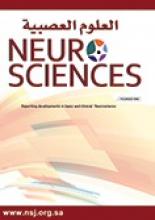Abstract
OBJECTIVE: To describe the patterns of formation, level of beginning, variations of course, and relation of the median nerve within the arm of human cadavers.
METHODS: Sixty upper limbs of 20 male and 10 female adult human cadavers were used in this study. The cadavers were obtained from the Anatomy Department, Faculty of Medicine, King Abdulaziz University, Jeddah, Saudi Arabia, and the study was conducted between February and December 2011. The axillary regions, arm, and forearm, of each limb were dissected to clarify the different patterns of median nerve formation and distribution within the arm.
RESULTS: The formation of the median nerve from 2 roots was found in 88.3% of upper limbs, while in 11.7% of upper limbs, it had 3 roots. Moreover, the median nerve began at the level of the third part of the axillary artery in 93.3% of upper limbs, and at the coracobrachialis muscle insertion in 6.7% of upper limbs. However, in correlation to the brachial artery, the median nerve had 6 patterns of relationship. The median nerve passed deep to the coracobrachialis and brachialis muscles in 8.3% of upper limbs. Meanwhile, the median nerve supplied the front arm muscles in 3.3% of upper limbs where the musculocutaneous nerve was absent. In 13.3% of upper limbs, the musculocutaneous nerve gave a communicating branch to the median nerve.
CONCLUSION: Knowledge of such variants of the median nerve helps clinicians and surgeons in the diagnosis of unexplained clinical cases.
- Copyright: © Neurosciences
Neurosciences is an Open Access journal and articles published are distributed under the terms of the Creative Commons Attribution-NonCommercial License (CC BY-NC). Readers may copy, distribute, and display the work for non-commercial purposes with the proper citation of the original work.






